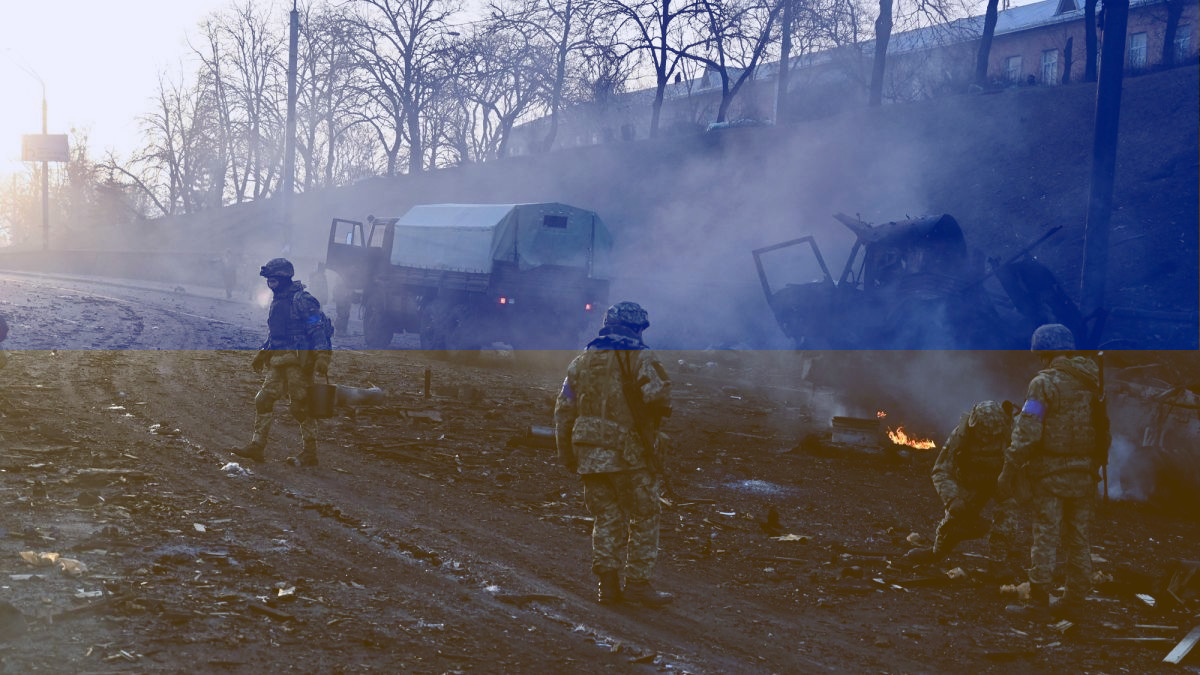War in the Ukraine, Worries at Home
Everything you need to know about the current war that has the whole world's attention
March 2, 2022
On February 24, Russian troops launched an attack on Ukraine.
It seems like everyone knows this by now: take a look at the news and social media and you can’t help but see tributes to the Ukrainian fighters, calls to boycott Russian businesses, photos of war zones, blue and yellow flags, and calls for peace.
But what is going on there exactly?
To answer why Russia has invaded Ukraine—and why Americans care so much—we’ll need to talk about a lot: the history of both Russia and Ukraine, America and the Cold War, the political rise of a comedian, and Elon Musk’s Twitter. This is by no means the complete story, and the situation is of course ongoing, but it should give you a clear idea about what is happening and why so you can talk about it without looking like a fool.
Brace yourself: this is a lot. It has taken an entire week to do all the research and update all the facts, and it has led to the longest article The Scout has ever published. But war is not a simple thing, and we wanted to be thorough and make sure we understood what is currently happening as completely as we could. This is a team effort: I’d like to give a shout out to editors Josh Bailey, Kaya Paluda, and Mr. Coon for checking facts, updating figures, and doing their best to help me keep this article as simple and straightforward as possible.
Let’s dive in.
The Build-Up of War
For almost a year, Russia has been moving troops closer to the border of Ukraine, claiming that his soldiers were participating in “training exercises.” Yet the soldiers never stopped coming, and by November, satellite image analysis from the US revealed at least 100,000 soldiers grouped in various camps along the Russian-Ukrainian border.
As Western countries began to ask Russian President Vladimir Putin about these troop movements, he became defensive. On December 17, he issued a warning to Western European countries to pull troops back from their borders with Ukraine and to not interfere with Russian affairs. While this clearly implied a future attack, the West believed that Russia was just using intimidation against Ukraine and wouldn’t make such a move while the pandemic was still thriving. President Biden said that he would have a phone conversation with Putin to talk about his concerns on January 26, but two days later, Putin told the press that his demands had not been addressed and that the West was not taking Russia seriously.
This rhetoric alarmed Biden, who sent 3,000 American troops to Ukraine in early February as a security force and a deterrent to a Russian invasion. Biden, French President Emmanual Macron, and German Chancellor Olaf Scholz all met with Putin in February to dissuade him from war, yet none of the talks were productive.
The Breaking Point
On February 21, Putin gave an address to his people declaring that Ukraine was under a puppet regime of Neo-Nazis under Ukrainian President Volodymyr Zelenskyy and, as Ukraine was once an important part of ancient Russia, that he would deploy peacekeeping forces to defend the Russian citizens of Ukraine if asked. Here, it’s important to note that while Ukraine has at times been part of Russia, it has always had a distinct culture, customs, and language. Zelenskyy is also not a Neo-Nazi, and as the grandson of a Jewish Holocaust survivor, he has pushed Ukraine to be a more open and inclusive society since he took his oath of office in May 2019. As the first Jewish president in a former Soviet bloc country, Zelenskyy had been the target of Russia’s centuries-long anti-semitism.
Immediately after this announcement, Ukrainian separatist groups in the regions of Donetsk and Lugansk took total control of the local governments and declared themselves to be independent, sovereign nations that had seceded from Ukraine. Tensions have been building in the region since 2014 after the annexation of Crimea. The separatists have claimed that, since the 2 million inhabitants of Donetsk and the 1.5 million inhabitants of Lugansk speak Russian and share Russian values, they need to be protected from the cruelty of Ukraine and their attempts to assimilate their culture.
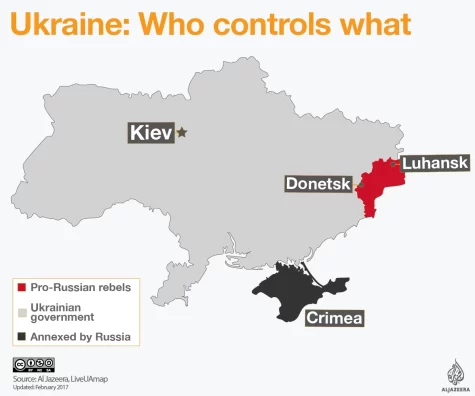
The separatist movement has gained support in the eight years since, as Russia has been sending the separatists money and resources to help them influence the people in the region. The areas even held two disputed elections in 2018 to elect “presidents” of their new republics: Denis Pushilin for the Donetsk People’s Republic and Leonid Pasechnik for the Luhansk People’s Republic.
The Ukrainian army immediately went into the region to stop Pushilin, Pasechnik, and their separatist supporters. On February 22, Pushilin and Pasechnik requested assistance from Russia, and the next day Putin recognized both areas and sent in his so-called peacekeeping forces to fight–so-called because they began sending rockets and bombs into the Ukrainian capital of Kyiv and other targets nowhere near the separatist regions.
Russia then moved invasion forces into Ukraine along its border and along the Belarusian-Ukraine border. Belarusian leader Alexander Lukashenko is a far-right nationalist and admirer of Putin, so Russia and Belarus have been close allies since Lukashenko’s election in 1994. Belarus allowed Russian troops to pass through their country so they could attack Ukraine from the north; for this action, some countries are starting to expand the economic sanctions placed on Russia to Belarus. There has also been a question of if Belarus would join Russia in its invasion of Ukraine: Ukraine claimed that a squadron of 33 Belarusian military units was spotted north of Kyiv, but US intelligence has not confirmed this information.
The Resistance Rises
Throughout the week, Russia has been targeting the capital city of Kyiv, which they hoped to take control of with military force. However, Ukraine’s military has held up surprisingly well considering their circumstances. They are severely outnumbered and underfunded when compared to Russia but have successfully used guerilla warfare against Russian troops. It seems that Russia thought that they would be welcomed as liberators and were genuinely shocked when the Ukrainians fought back. President Zelenskyy asked all men in the country between 18 and 60 to take up arms against the Russians, and most of them have. Even those who can’t fight are helping the cause: teams of mothers and grandmothers are making Molotov cocktails to throw at soldiers, and teenagers too young to fight are removing and replacing road signs so invading Russians will get lost.
Perhaps the biggest asset to the Ukrainian cause is President Zelenskyy. Zelenskyy and the members of his cabinet have been fighting in the streets of Kyiv and posting social media videos to encourage the people of Ukraine. Zelenskyy has recently gone underground for his own safety, as he is Russia’s number one target (with his family as number two), but he refuses to leave his country. When the American State Department offered to get Zelenskyy out of the country, he replied, “I need ammunition, not a ride.” A former actor and comedian, Zelenskyy is the most popular Ukrainian leader in recent history, and his courage and charm have won him fans from all over the world.
Another reason that Ukraine currently has an advantage is due to the fact that the Russian troops seem to be very ill-prepared. When captured by Ukrainian citizens, several troops have told the Ukrainians that they were told this was all part of training exercises. When told by the Ukrainians what was truly going on, many have refused to fight or have even helped Ukraine. Still other soldiers are sabotaging and abandoning their tanks, as they don’t want to fight Ukraine, as it is common in Russia to have friends and extended family living in Ukraine. While there are plenty of Russian soldiers looting homes and killing opponents, the low morale of a large number of troops is hindering Russia’s battle plans.
This is not to say that the fighting hasn’t been bad. Today, Ukraine has reported over 2,000 deaths, while Russia has reported its first death. These numbers are obviously suspect: the UN has difficulty confirming casualties in an active war zone, is Russia is definitely not reporting all casualties. More than that, the constant bombing of Kyiv (a city about the same size as Chicago) and Kharkiv, Ukraine’s second-largest city (around the size of San Diego), has displaced more than 800,000 Ukrainian citizens. A majority of these refugees are trying to flee the country through neighboring Poland.
While trains are running night and day to get Ukrainian citizens to safety, these refugees still face major problems after leaving Ukraine. BIPOC individuals fleeing Ukraine are finding they aren’t being allowed through certain checkpoints on account of their race, and not all countries have been welcoming these refugees. Governor Jared Polis has pledged that any Ukrainian refugees may find sanctuary in Colorado… if they can get here. Some refugees lost everything, including identification and valuables, so traveling is extremely difficult for a majority of refugees. Several countries (including the United States) are also facing criticism for welcoming white European refugees from Ukraine when they have refused Syrian and Haitian refugees in the past couple of years.
The Bitter History of Russia and Ukraine
But why has Russia attacked Ukraine? While the two countries have had conflicts throughout history, the current conflict starts with the dissolution of the Soviet Union in 1991. The Soviet Union was a collection of countries under Russia’s sphere of influence under Vladimir Lenin, who led the Communist Revolution in Russia in 1917. Ukraine was a founding member of the Soviet Union when it was formed in 1922, but the country radically changed under Lenin’s successor Josef Stalin. Stalin was an autocrat who insisted that all Ukrainian people speak Russian instead of Ukrainian, that cities be renamed after Russian heroes, and that Ukrainian resources go directly to Moscow for distribution. Like everywhere else in the Soviet state, citizens lived under poor economic conditions while its leaders hoarded the wealth of its satellite nations and enforced its policies through the actions of the KGB, the hyper-militant Russian security force. Soviet dissidents would not only be brutally punished, but they would just disappear entirely–the KGB would edit photos and official documents to make it as if that person never existed.
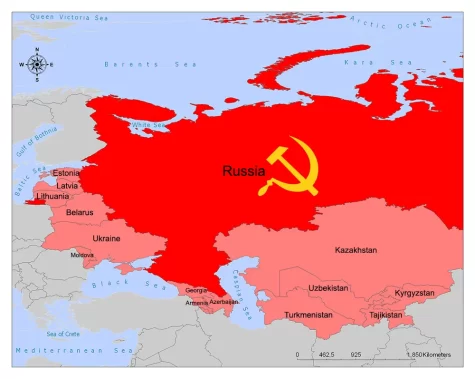
Alarmed by the threat of the Soviet Union, America and the republics of Western Europe formed their own union–the North American Treaty Organization, or NATO. NATO countries were all bound by a pledge that an attack on one of the member countries was an attack on all, a pledge that kept the Soviet Union from directly confronting these nations. This “Cold War” saw NATO and the Soviets fight proxy wars in so-called third-world countries, i.e. the ones not part of NATO or the Soviet Union. These wars included the Korean War, the Vietnam War, and the British-Afghan War.
Eventually, after years of failing economic policies and corruption, the Soviet Union broke up, and nearly every member country became a democracy, including Ukraine and Russia. However, NATO was kept alive just in case a common threat to the member countries would ever rise again. Russian President Boris Yeltsin was very open with the West and wanted to make peace with his former enemies: through Yeltsin, Russia joined important global partnerships like the G8.
In 1999, Yeltsin left office because of term limits and was replaced by Vladimir Putin, a former KGB operative who still held hope that the Soviet Union would reform. Russia saw incredible growth under Putin, who served as President until 2008–like Yeltsin, he was blocked by term limits. Putin was soon elected as Russia’s Prime Minister (the head of Congress), and as PM, Putin radically changed Russian laws: he narrowed the scope of what media was allowed in the country, he put harsher restrictions on free speech, and he got rid of term limits for the President. Putin resumed the Presidency in 2012 and has been an autocrat ever since. While Russia still has elections, most of Putin’s political rivals are blocked from running, arrested, or die under unusual circumstances. In essence, he has become the 21st-century version of Josef Stalin.
Once Putin had control, he focused on getting the Union back together, as this would increase his own wealth and power. This proved tricky: the former Soviet countries seemed to really like democracy and self-governance and did not want to form a new Soviet state. Worse, some former Soviet countries joined the European Union and even wanted to join NATO. To stop this, Putin has funded pro-Russian groups in former Soviet countries and has waged cyber-terrorism against NATO countries, including the US. But when this didn’t work, Putin went to war.
Modern Russia vs. The World
The invasion of Ukraine marks the third European war of the 21st century. The first happened in 2008 when NATO considered membership requests from the Republic of Georgia and Ukraine. Enraged, Putin declared an area of Georgia called South Osseda an independent country and sent troops in to “keep the peace” in Georgia. The Georgian people and their allies fought back, and Georgia expelled the Russians quickly, ending the war in eight days. However, the Russians managed to permanently damage Georgian historical landmarks and create refugee and housing crises that still plague Georgia today. More to the point, Georgia withdrew its bid from NATO out of fear of further attacks.
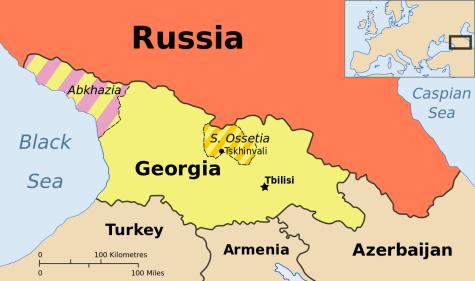
While his first war wasn’t successful, Putin’s second war was. In 2014, Russia annexed the Crimea Penisula, a small region that connects Ukraine and Russia across the Black Sea. In 2013, Ukraine was approached to join the European Union. Ukrainian President Viktor Yanukovych, a pro-Russian politician who was funded by Putin, refused to allow Ukraine into the European Union. This led to massive protests throughout Ukraine which became the Revolution of Dignity.
In February, Ukrainians drove Yanukovych and his corrupt allies out of power (they currently live in exile in Russia) and established a pro-European government. In response, Putin had soldiers take over Crimea’s Supreme Council, who then declared Crimea as an independent nation from Ukraine. Putin instantly recognized this new country and sent in its “peacekeeping force.” Ukraine and its allies were furious, but the revolution-backed government was in no shape to repel the Russians. Other countries did not want full war with Russia, so instead of sending soldiers to take back Crimea, Russia was kicked out of the G8 (it’s now the G7) and its aid from the West was cut off. This was also when Donetsk and Luhansk started their separatist movements, which have caused 14,000 deaths over the last eight years.
Fast forward to today: Putin is pulling the same trick a third time and hoping it resembles the skirmish in Crimea more than the skirmish in Georgia. But why now?
The Current Crisis in Europe
The biggest threat to Russia isn’t the armies and nuclear weapons of the NATO alliance but its ideas: Putin is an autocrat with total power, and thus his enemy is the democratic way of life. If the power were in the hands of his people and Russia’s elections weren’t rigged, he and his corrupt friends would have been voted out of office long ago. This is why democracy is so toxic to Putin: he doesn’t want any of those ideas spreading to his country. That’s why he tightly controls Russian media and Russian access to the outside world, but he can’t keep his people from traveling to the many countries that border Russia. So Putin’s strategy is to get all these former Soviet countries back into his sphere of influence or to damage their democracy so badly that it won’t look good by comparison.

Putin left Ukraine alone for the most part from 2010 to 2014 when Viktor Yanukovych was in power, as Yanukovych was pro-Russia and not big on democracy–but as soon as Yanukovych lost power, Russia took Crimea before it could lose influence in the region. Russia has similarly felt threatened after the election of President Zelenskyy in 2019, as he vowed to purge Ukraine of corrupt politicians and drive Russian influence out of the country. This, of course, made him a target of Putin.
Putin also wants Ukraine under his control so he can exploit its resources. Like Stalin before him, Putin has enriched himself over the year by stealing from his people: while it’s impossible to say how much he has stolen, most experts believe that Putin is secretly the richest man in the world. To hide this money, Putin has a close circle of oligarchs, which are rich business leaders with immense influence all over the world. These oligarchs funnel Putin’s money into real estate and bank accounts in the West.
So how would Ukraine enrich Putin? Donetsk is a mining town and a manufacturing powerhouse, creating a good deal of Europe’s steel. Luhansk has massive coal reserves. More broadly, if Putin had control of Ukraine, he would have control of vast reserves of iron ore, cobalt, nickel, sulfur, and titanium, all metals that are used to make the batteries and chips in our electronic devices. He would also control Ukrainian farmlands that produce much of Europe’s wheat and potatoes, and most of the world’s sunflower oil (it is the national flower). Despite Russia’s size, only 13% of its land can be used to grow crops, and while that still gives them 123 million hectares of land, the acquisition of Ukraine would increase that land by a third–and deprive NATO countries of one of their food sources.
However, another factor in Putin launching the attack now is us. While America has always been a key part of NATO, Americans started questioning the relevancy of NATO when part of the “Make America Great Again” platform was to withdraw from NATO if other member countries did not meet their financial responsibilities. This refers to the NATO agreement that every NATO country would invest 5% of their GDP into its defense budget, yet only two member countries have done that in the past decade: Lithuania and the United States. Whether or not this critique came from the Donald Trump’s good working relationship with Putin or not, the Russian president saw cracks in the NATO armor.
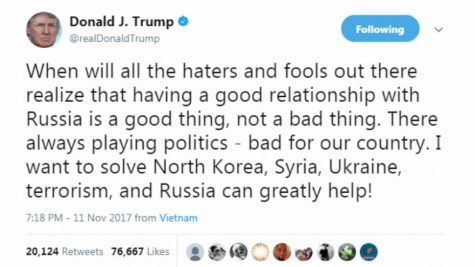
Two months after Zelenskyy was elected, the US voted to suspend aid to Ukraine (and when evidence emerged that this was done in order to pressure Zelenskyy to release evidence against the Biden family, it resulted in the first impeachment of Donald Trump). However, President Biden has restored that aid package and has been a close ally of Zelenskyy. Putin may have chosen to attack now to take advantage of the fractured political state of America before they further allied with Ukraine. Other NATO allies are also going through political strife: the UK has been rocked by the Partygate scandal, Germany’s new chancellor is still learning the ropes of his new job, Canada is struggling with a wave of anti-government protests as a result of COVID restrictions, and France has been struggling with civil unrest ever since the Yellow Vest revolt of 2018.
The other factor that makes now an advantageous time for Russia to attack Ukraine is that they can keep the United Nations from getting too involved. Like the US, Russia is a founding and permanent member of the UN. The United Nations Security Council is the UN’s decision-making body on when to deploy UN peacekeeping troops and step into territorial disputes between countries. The leadership of this body rotates among the founding member countries, and unfortunately, Russia currently controls the committee. Since Russia refuses to get the UN involved in the conflict and since the country has a permanent seat and can’t be kicked out of the UN, the UN cannot force Russia to withdraw nor can they support Ukraine outside of aiding with the refugee crisis.
Where It Will Go From Here
Unfortunately, it does not look like Russia will be backing down anytime soon. On Monday, Lukashenko hosted the first meeting between Russian and Ukrainian officials since the Russian invasion began. However, the meeting was not helpful, as discussions broke down after Russia denied any wrongdoing. Russia is currently sending a convoy of tanks 40 miles long to invade Kyiv, yet today it looked like the convoy was slowing and shrinking due to issues with troop fatigue and desertion. Putin is also escalating his rhetoric, putting his nuclear reserves on high alert to threaten any country that dares to interfere.
It’s unclear what exactly may happen if Putin succeeds in taking over Ukraine. In a public statement by Lukashenko, he inadvertently revealed a map showing Russian troops moving into the former Soviet state of Moldova from the Ukrainian port of Odesa–an indication that Putin will continue his current trajectory of expanding his sphere of influence of force. Putin has said that only one thing will make him stop: if NATO returns to its 1945 borders, meaning that NATO would have to abandon member countries Poland, Lithuania, Estonia, and Latvia. And if Putin decides to use nuclear weapons, it seems that a World War would be inevitable.
However, the U.S. Treasury Department has seen success in freezing Russia’s central bank assets. “The unprecedented action we are taking today will significantly limit Russia’s ability to use assets to finance its destabilizing activities and target the funds Putin and his inner circle depend on to enable his invasion of Ukraine,” Treasury Secretary Janet L. Yellen said in a statement.
So what do these sanctions do? Basically, every US business is to cut ties with Russia by ending partnerships or freezing Russian assets (meaning that Russians can’t access money or other resources that are in control of American banks). These alone would hurt Russia’s weak economy (which is on par with countries like Panama and Cuba), but the sanctions from America’s allies have really affected Russia. The UN General Assembly voted today to condemn Russia’s attack. Germany, Russia’s largest trading partner, has stopped all supply lines into Russia and has donated all military equipment purchased from Russia to Ukrainian forces. Famously neutral Switzerland has made the unprecedented move of freezing Russian assets in the country. Even the Talibani government of Afghanistan has called for a cease-fire.
Corporations are also getting involved. Mastercard and Visa have cut Russia off from their services, and NATO’s decision to remove Russia from the SWIFT financial system has prevented most electronic payments. Russians have not only lost access to bank accounts but also other means of income: social media influencers in Russia can no longer get paid by Patreon, TikTok, and other services, and Russian gamers have found their accounts deleted and any purchased content is gone. On the flip side, many businesses are donating money or supplies to the Ukraine resistance. When Russia cut Ukraine’s internet, Elon Musk deployed his Starlink nodes to keep Ukraine connected (some critics argue that this is more about protecting his source of Tesla batteries than his care for the Ukrainian people).
This has all led to the Russian economy diving into freefall as intelligence agencies around the world are uncovering and seizing Putin’s hidden wealth. This, along with the inhumanity of the attacks, has Russia facing internal conflict from its citizens protesting the Ukrainian invasion. Over 6,800 Russian citizens have been arrested following protests in St. Petersburg, Moscow, and other cities against Putin’s actions. Despite crackdowns on protestors, Putin’s main political rival Alexi Navalny has been calling for nationwide resistance in Russia from his Siberian jail cell (he was arrested on bogus charges once he returned to Russia after going to Germany to get medical treatment after Putin’s men poisoned him).
The Russian invasion of Ukraine will also have a deep impact on the US economically and politically. Oil prices have been rising since the beginning of January, but since the talks of invasion, the price of oil per barrel has gone up 24%. The stock market has also been more volatile, as wars make market security unpredictable. His handling of the Ukraine crisis has also led to a small improvement on Biden’s approval rating: most Americans wanted us to do something about the invasion without putting our soldiers on the ground, and that’s what we’ve done.
Only time will tell if that was the right solution. Until then, there is only one thing we do know, as summarized by a sign a Ukrainian protester held up during the invasion: “If Russia stops fighting, there will be no more war. If Ukraine stops fighting, there will be no more Ukraine.”
We will continue to update this article as more news becomes public over the next couple of weeks
